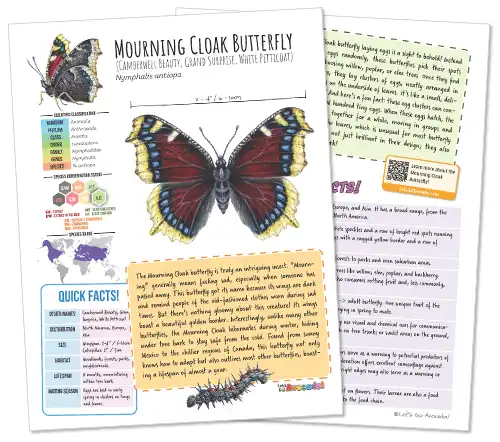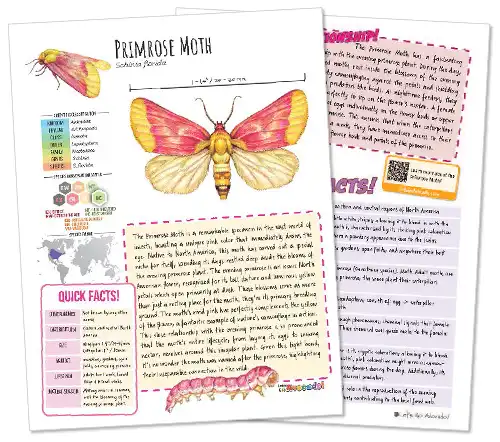-
 Latin Name:Danaus plexippusLocations Found:Predominantly found in North and South America. However, they have also been found in other parts of the world, including the Pacific Islands, the Canary Islands, and Western Europe.Characteristics:Caterpillar: Brightly striped in yellow, black, and white. Butterfly: Orange wings with black veins and white-spotted black borders.
Latin Name:Danaus plexippusLocations Found:Predominantly found in North and South America. However, they have also been found in other parts of the world, including the Pacific Islands, the Canary Islands, and Western Europe.Characteristics:Caterpillar: Brightly striped in yellow, black, and white. Butterfly: Orange wings with black veins and white-spotted black borders. -
 Latin Name:Nymphalis antiopaLocations Found:This butterfly is found in North America, Europe, and Asia. It has a broad range, from the cold arctic regions to the warmer parts of North America.Characteristics:Caterpillar: Spiky black body covered with white speckles and a row of bright red spots running down the back. Butterfly: Dark maroon wings with a ragged yellow border and a row of iridescent blue spots.$ USD054Was: $0.73
Latin Name:Nymphalis antiopaLocations Found:This butterfly is found in North America, Europe, and Asia. It has a broad range, from the cold arctic regions to the warmer parts of North America.Characteristics:Caterpillar: Spiky black body covered with white speckles and a row of bright red spots running down the back. Butterfly: Dark maroon wings with a ragged yellow border and a row of iridescent blue spots.$ USD054Was: $0.73 -
 Latin Name:Papilio canadensisLocations Found:Found throughout Canada, from the northern parts of the Great Lakes, across the boreal forest to Alaska, and extending into the northern regions of the US, particularly in the Rocky Mountains.Characteristics:Caterpillar: They are initially brown and white, resembling bird droppings, but as they grow, they turn green with a pair of yellow eyespots with black and blue centers on the thorax. Butterfly: It has yellow wings with black tiger striping. There's a splash of blue and orange near the tail of the hindwing.
Latin Name:Papilio canadensisLocations Found:Found throughout Canada, from the northern parts of the Great Lakes, across the boreal forest to Alaska, and extending into the northern regions of the US, particularly in the Rocky Mountains.Characteristics:Caterpillar: They are initially brown and white, resembling bird droppings, but as they grow, they turn green with a pair of yellow eyespots with black and blue centers on the thorax. Butterfly: It has yellow wings with black tiger striping. There's a splash of blue and orange near the tail of the hindwing. -
 Latin Name:Hyalophora cecropiaLocations Found:Found across the eastern and midwestern regions of North America, from the Rocky Mountains eastward through most of the US to the maritime provinces of Canada.Characteristics:Caterpillar: The larva is bright blue-green and adorned with tubercles that have spiky, silver-colored setae. Moth (not butterfly): The adult moth is a vivid blend of red, white, and brown with crescent-shaped white marks on the wings. The body is red with white bands, and the wings have eye-like patterns, helping deter potential predators.
Latin Name:Hyalophora cecropiaLocations Found:Found across the eastern and midwestern regions of North America, from the Rocky Mountains eastward through most of the US to the maritime provinces of Canada.Characteristics:Caterpillar: The larva is bright blue-green and adorned with tubercles that have spiky, silver-colored setae. Moth (not butterfly): The adult moth is a vivid blend of red, white, and brown with crescent-shaped white marks on the wings. The body is red with white bands, and the wings have eye-like patterns, helping deter potential predators. -
 Latin Name:Eacles imperialisLocations Found:Found in the eastern part of North America, from southern Canada down through the eastern United States to Mexico.Characteristics:Caterpillar: The caterpillar goes through several color phases, but mature larvae are typically a greenish-yellow with blue tubercles and pinkish/red setae (hairs). Moth (not butterfly): The adult Imperial Moth is characterized by its bright yellow coloration with pinkish, brown, or purplish spots and lines.
Latin Name:Eacles imperialisLocations Found:Found in the eastern part of North America, from southern Canada down through the eastern United States to Mexico.Characteristics:Caterpillar: The caterpillar goes through several color phases, but mature larvae are typically a greenish-yellow with blue tubercles and pinkish/red setae (hairs). Moth (not butterfly): The adult Imperial Moth is characterized by its bright yellow coloration with pinkish, brown, or purplish spots and lines. -
 Latin Name:Actias lunaLocations Found:Found throughout the deciduous forests of the eastern part of North America, ranging from Canada down to Florida and west to Texas.Characteristics:Caterpillar: The caterpillar is bright green with a white border running down its sides, small orange spots, and sparse long, bristle-like hairs. Moth (not butterfly): The adult Luna Moth is known for its large, pale green wings and distinctive tail extensions on the hindwings. The wings also feature a transparent eyespot on each.
Latin Name:Actias lunaLocations Found:Found throughout the deciduous forests of the eastern part of North America, ranging from Canada down to Florida and west to Texas.Characteristics:Caterpillar: The caterpillar is bright green with a white border running down its sides, small orange spots, and sparse long, bristle-like hairs. Moth (not butterfly): The adult Luna Moth is known for its large, pale green wings and distinctive tail extensions on the hindwings. The wings also feature a transparent eyespot on each. -
 Latin Name:Battus philenorLocations Found:The Pipevine Swallowtail is found in many parts of North America, from Central America north through Mexico and the United States to Canada.Characteristics:Caterpillar: The caterpillars are black with bright orange-red spots, making them easily distinguishable from many other caterpillars. Butterfly: The adult butterfly has iridescent blue or blue-green wings on its dorsal side. The underside is black with a row of orange spots on the edge of the hindwing.
Latin Name:Battus philenorLocations Found:The Pipevine Swallowtail is found in many parts of North America, from Central America north through Mexico and the United States to Canada.Characteristics:Caterpillar: The caterpillars are black with bright orange-red spots, making them easily distinguishable from many other caterpillars. Butterfly: The adult butterfly has iridescent blue or blue-green wings on its dorsal side. The underside is black with a row of orange spots on the edge of the hindwing. -
 Latin Name:Schinia floridaLocations Found:The Primrose Moth is found mainly in the eastern and central regions of North America.Characteristics:Caterpillar: The caterpillar is green with subtle white stripes, allowing it to blend seamlessly with the plants on which it feeds. Moth: The adult moth is characterized by its striking pink coloration and yellowish-tan bands. The wings often have a powdery appearance due to the scales.$ USD054Was: $0.73
Latin Name:Schinia floridaLocations Found:The Primrose Moth is found mainly in the eastern and central regions of North America.Characteristics:Caterpillar: The caterpillar is green with subtle white stripes, allowing it to blend seamlessly with the plants on which it feeds. Moth: The adult moth is characterized by its striking pink coloration and yellowish-tan bands. The wings often have a powdery appearance due to the scales.$ USD054Was: $0.73 -
 Latin Name:Polygonia interrogationisLocations Found:This butterfly is found mainly in North America, ranging from southern Canada to central Mexico. It is especially prevalent in the eastern United States.Characteristics:The upper side of the wings is bright orange with black spots, resembling the coloration of many other nymphalid butterflies. The underside is more cryptic, with a combination of browns and tans, resembling a dead leaf. The most distinctive feature is a small white mark on the underside of the hindwing, which looks like a question mark, thus the butterfly's name.
Latin Name:Polygonia interrogationisLocations Found:This butterfly is found mainly in North America, ranging from southern Canada to central Mexico. It is especially prevalent in the eastern United States.Characteristics:The upper side of the wings is bright orange with black spots, resembling the coloration of many other nymphalid butterflies. The underside is more cryptic, with a combination of browns and tans, resembling a dead leaf. The most distinctive feature is a small white mark on the underside of the hindwing, which looks like a question mark, thus the butterfly's name. -
 Latin Name:Vanessa atalantaLocations Found:This butterfly is found in temperate regions of North America, Europe, Asia, and North Africa. It’s especially common across Europe and the British Isles.Characteristics:The Red Admiral has a dark black-brown base color on the upper side of its wings with distinctive red-orange bands running horizontally across the forewings and around the edge of the hindwings. There are also small white spots on the tips of the forewings.
Latin Name:Vanessa atalantaLocations Found:This butterfly is found in temperate regions of North America, Europe, Asia, and North Africa. It’s especially common across Europe and the British Isles.Characteristics:The Red Admiral has a dark black-brown base color on the upper side of its wings with distinctive red-orange bands running horizontally across the forewings and around the edge of the hindwings. There are also small white spots on the tips of the forewings. -
 Latin Name:Limenitis arthemis astyanaxLocations Found:This butterfly is found mainly in North America, across a broad range including the eastern United States west to the Rocky Mountains and into parts of southern Canada.Characteristics:The butterfly displays a dazzling array of colors - shimmering blue on the upper sides of its wings, offset by bright, red-orange spots on the hind wings. The underside is a mottled combination of blue, black, and orange.
Latin Name:Limenitis arthemis astyanaxLocations Found:This butterfly is found mainly in North America, across a broad range including the eastern United States west to the Rocky Mountains and into parts of southern Canada.Characteristics:The butterfly displays a dazzling array of colors - shimmering blue on the upper sides of its wings, offset by bright, red-orange spots on the hind wings. The underside is a mottled combination of blue, black, and orange. -
 Latin Name:Grammia virgoLocations Found:The Virgin Tiger Moth can be found throughout much of North America.Characteristics:The adult moths are typically white with a smattering of black dots or splotches across the wings. The caterpillar is densely covered with bristles and varies in color but is commonly yellow or orange with black bands, hence the "Yellow Woolly Bear" moniker.
Latin Name:Grammia virgoLocations Found:The Virgin Tiger Moth can be found throughout much of North America.Characteristics:The adult moths are typically white with a smattering of black dots or splotches across the wings. The caterpillar is densely covered with bristles and varies in color but is commonly yellow or orange with black bands, hence the "Yellow Woolly Bear" moniker. -
 Latin Name:Limenitis arthemisLocations Found:The White Admiral Butterfly is primarily found in North America. Its range extends from eastern North America, including parts of the United States and Canada, down to the southern United States, and as far west as the Great Plains. It can also be found in certain parts of Mexico.Characteristics:The White Admiral Butterfly is known for its distinctive features, including its deep black wings with white bands and striking iridescent blue markings near the edges of the wings. It also has a row of conspicuous red spots on its hindwings. These striking patterns make it easily recognizable.
Latin Name:Limenitis arthemisLocations Found:The White Admiral Butterfly is primarily found in North America. Its range extends from eastern North America, including parts of the United States and Canada, down to the southern United States, and as far west as the Great Plains. It can also be found in certain parts of Mexico.Characteristics:The White Admiral Butterfly is known for its distinctive features, including its deep black wings with white bands and striking iridescent blue markings near the edges of the wings. It also has a row of conspicuous red spots on its hindwings. These striking patterns make it easily recognizable.



